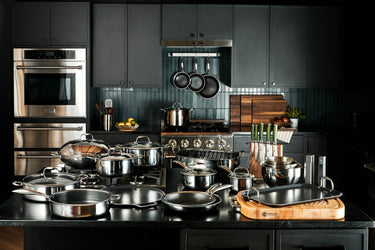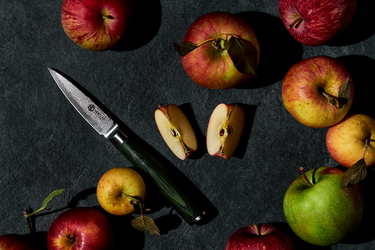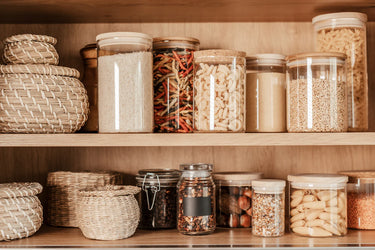HexClad vs. All-Clad: Which One Is Right for You?

You hear many buzz words surrounding cookware. They can get overwhelming, not to mention confusing.
While we can argue that you should know as much about cookware as possible, at the very least, to make informed choices, we also think you should get accurate information from a source you can trust.
That’s how you ended up here. HexClad has trustworthy information on the differences between our brand and All-Clad that can help you make the right choice. By the end of this read, you should know all the ins and outs of these two products to make the best, informed decision about which one is right for you.
Hint: it’s definitely ours!
The History of Cookware
Cookware has come a long way throughout the years. We can trace the first evidence of cookware used to make food back about 15,000 years.
At the time, ancient communities in what is now modern-day Japan used clay pots to make fish soup, leading to the earliest known cookware.
These clay pots were called donabe and still exist in various capacities today. They are what we now know as hot pots, and you can cook a lot more with them than fish soup.
Donabes are now functional for many dishes and are aesthetically pleasing. While they’re still in use, donabes aren’t a part of an everyday kitchen outside of Japanese culture.
If you want something to compare a donabe to, consider a cast-iron skillet or dutch oven. This style of cookware heats up slowly, but once it reaches a cooking temp, it retains heat very well.
The look may have evolved, but the cooking ability has remained tried and true since the beginning. These precursors to modern cookware have also evolved in many directions, giving us all kinds of pots and pans to cook on.
What Cookware Looks Like Today
While some tribes still utilize clay pots to create indigenous dishes, most of our cookware has evolved to take on many forms.
Items like dutch ovens can be traced back to France, and brick ovens are a traditional piece of Italian kitchens.
In most of our homes, we utilize stainless steel and aluminum pans for our daily labors. But some of us also own prized cast-iron skillets that are heavy and a pain to use, but sear meat so perfectly that many think they’re worth it.
There’s a lot of history behind your pans that you may not even realize exists. So, the next time you’re sliding a fluffy omelet out of your hot skillet, think of the generations of humans that made this possible.
All that history has led us to the two brands we’re going to be discussing today: HexClad and All Clad — but first, let’s discuss what to look out for when purchasing cookware.
What Should You Look for When Buying Cookware?
Choosing cookware and deciding between two products isn’t easy, but there are certain points and considerations you need to make. The items below are the main points you need to ask yourself and the products in question before making any purchases.
Versatility
We don’t expect one pan to do everything, but we also don’t want a million pans that only serve one purpose. You should be able to expect at least some versatility from an excellent product, however. .
This leads us to one critical point you’ll want to consider: the product's heating capability or thermal conductivity.
This is how well the pot or pan reacts to and with heat. You’ll need to ask yourself (or the company you’re considering buying from) two main questions.
- How long does it take to heat up?
- How well will it keep the heat once it is warmed up and ready to use?
Reactive vs. Non-Reactive
One of the more essential qualities of the pans you use daily is the type of metal you are cooking on. You’ll need to know if you are using reactive or non-reactive cookware.
A reactive pan uses a type of metal that will react with acidic or any food with a high pH balance. A rich tomato sauce or a lemon and white wine reduction will cause the pan to react or corrode and impart flavor and discoloration to your food.
A nonreactive pan uses a metal that can stand up to these foods without issue.
Reactivity might not seem like a big deal; however, using reactive pans means you’re ingesting these metals.
When you’re looking for a pan or set of pans, choose options that aren’t going to react with acidic foods.
Maintenance
Copper pots are beautiful and look amazing on display in the kitchen (though they cost a small fortune). However, they are tough to take care of and require hand polishing before and after use. Under no circumstances are you to put these in the dishwasher.
The maintenance of your cookware is an especially big issue for those cooking for large families nightly, although it can still be problematic for those among us who don’t enjoy washing dishes. Not only will you spend ample time creating the dishes, but you will spend even more time taking care of them.
If you aren’t cooking often, the maintenance might not bother you as much. For daily use, it would be easier to have pots and pans that can go straight from the stove to the dishwasher.
Durability
When it comes to our pans, we shouldn’t have to replace them as often as our toothbrushes. That’s why we consider the durability of our cookware consequential.
If you cook every day, you’ll need a pan that can stand up to this sort of wear. While specialty pans may be great for specialty dishes, we know those particular pieces of cookware just weren’t made to be used daily.
A good rule of thumb is to weigh what you’re cooking versus what you bought to cook it in. If you chose a gorgeous white enamel dutch oven for those delicious short ribs you love to make for big family gatherings, consider that a specialty piece of cookware in your kitchen.
It’s strong, but it can’t do everything, and we shouldn’t expect it to. You’re not going to use it every single day to cook.
Pricepoint
An excellent way to consider purchase price is to consider the best pots and pans that fit your budget.
It may be a great deal if it’s on sale or clearance, but it may also be a total disaster when you get it home.
Purchase price comes into play the most when you weigh all the different product points above against the costs. Again, you love that dutch oven, but you don’t need five, considering what you paid for one piece. This is essential when you factor in the amount of use.
What Does the “Clad” Mean?
We are finally going to get to the nitty-gritty details of each product, but we want to start by explaining what is meant by clad.
Clad refers to styles of products with a metal core that is different from the exterior. The clad means that the metals are bonded fully into one complete pan.
It’s a small but very distinct detail.
What Features Can You Expect From HexClad
We don’t want to pick favorites, but we’re starting with our favorite product of the two options.
We believe that our product is the best cookware on the market, and we know after comparing these two items, you’ll agree.
HexClad’s Design
Our design is unlike any other. Our innovative cooking surface features a peaks and valleys hexagon design. This patented design provides even heating and a nonstick surface. The peaks are stainless steel and the valleys utilize a nonstick surface that will allow your meal to slide with ease..
Our pots and pans lids are fitted with stainless steel rims and a glass top.
They’re also easy to clean and dishwasher safe. Our pots and pans have a stainless steel exterior and feature a stainless steel handle that stays cool while cooking.
HexClad’s Composition
The technology behind the composition of our products creates a kickass cooking experience. We use a revolutionary design with a tri-ply clad makeup and the peaks and valleys we talked about earlier.
We start with magnetic stainless steel for a surface that can work even with the newer induction stoves. Then we add a layer of aluminum for a perfectly even heating surface.
On top of that is another layer of stainless steel that is etched with our hexagon peaks and valleys. When seasoned properly, this composition creates a pan that works like an everyday stainless steel pan, but sears like a cast-iron skillet.
HexClad’s Variety
We have one collection with a lot of variety. You can purchase a complete 13-piece set, a seven-piece set, or each pan and lid individually.
When you make a superior product, one collection of pots and pans isn’t enough. We also sell each item separately to make it easy to pick and choose which pieces you need when your old pans wear out.
HexClad’s Heat Safe Temperatures
Our pots and pans are safe for high heat on the stove and can withstand up to 500 degrees in the oven.
Oven transfers have never been easier. You can sear your meat and then finish it off in the oven — same pan, no problem. Plus, no worries about ruining the handle.
One note about our products on the range: we don’t recommend using high heat when it isn’t necessary, because you won’t need it. We design our products to give you an even heating surface and a nonstick cooking experience.
Still, the best way to use HexClad products is to season beforehand and use them on low and medium settings. These settings create the best temperature for the nonstick surface and keep your food from burning prematurely due to intense surface temperature.
HexClad’s Range of Use
We make our pots and pans for everyday use and all types of culinary adventures. Our pans are great for chefs with a broad range of skills in the kitchen. They’ll also make a great addition to a novice cook’s kitchen as they become the Gordon Ramsay of home cooking.
We created our pans to give you the most range of recipes and styles of cuisine. You don’t have to feel limited on anything you want to try.
You can utilize our pans for the most delicate of sauces and the toughest of meats. The sky’s the limit, thanks to our unique technology.
What Features Can You Expect From All-Clad
While we would love to stop there, we did promise you a comparison of HexClad and All-Clad pans. All-Clad has a lot of products similar to what we create.
However, we don’t think there’s any competition. We know that our cookware is ready to stand up to any competitor, anytime. But in the spirit of a fair match, these are the product highlights for All-Clad pots and pans.
All-Clad’s Design
All-Clad has a lot of collections and a few different finishes. However, the overall design and shape, however, remain the same.
Depending on the composition of the pots and pans, All-Clad has a matte black finish, a copper finish, or a stainless steel finish. These design and style points also come with different price points.
All-Clad also features a stainless steel lid that, depending on the collection purchased, may have distinct design components to signify the difference between models.
The biggest downside of All-Clad designs, as well as user-friendliness, is the handles. They’re straight and slim, offering less ease of use when compared to HexClad cookware.
All-Clad’s Composition
The design of All-Clad varies due to the range in composition. All-Clad features seven collections in total, each with a different core.
The copper design utilizes a copper interior, and so on. You can use six out of seven of the collections on an induction stove, and the odd man out is their least expensive basic line.
All-Clad’s Variety
All-Clad has a lot of variety, but their least expensive line doesn’t offer the user many of the same benefits as our single collection.
While they may have more options and collections available to date, we made sure not to leave anything out the first time around.
All-Clad’s Heat Safe Temperatures
All-Clad pots and pans are also designed for use in the oven, with all collections being safe up to 500 degrees in the oven. The top-tier collections (the two most expensive) can withstand oven temperatures at 600 degrees.
One critical heat feature to note: none of the All-Clad lids can be used in the oven, meaning that you won’t be able to use your All-Clad pots or pans for a braising recipe that requires a tight-fitted lid.
The handles of All-Clad products also don’t do as well in the oven and will wear and tear more quickly with this type of use.
All-Clad’s Range of Use
All-Clad does a wide range of use, thanks to the sheer amount of collections they carry.
This means that you won’t be limited in your culinary techniques and skills in the kitchen, but it comes at a price.
You will have to buy multiple products from multiple collections to get the full range of techniques and utensils. It’s not as easy as one collection, and you’re done. You will have to give your wallet a serious workout to get the vast range of use from All-Clad.
The Price Point Difference Between HexClad and All-Clad
Because All-Clad has more collections, their prices vary. However, our collection can do everything their best collection is capable of — and at a lower price.
Choosing the most expensive option doesn’t always mean it’s superior or offers more range, especially considering their handles and lids don’t stand up to the oven heat the way ours do.
Time To Make Your Choice
Now that you have all the information on these two styles of products, we are sure it’s pretty clear why we made HexClad.
We know you might be able to be pretty content with any other product and be able to come up with some wild and delicious creations. But we didn’t make our pots and pans for you to be just content in the kitchen.
We created our superior pots, pans, knives, and bowls to create a superior cooking experience that leaves you fully satisfied. Just like Gordon Ramsay, we don’t expect you to settle for anything less than the best.
Sources:
Cooking with Donabe: The Japanese Clay Pot | NHK WORLD
Full article: Thermal Conductivity Measurement and Prediction of Particulate Foods | TandF





